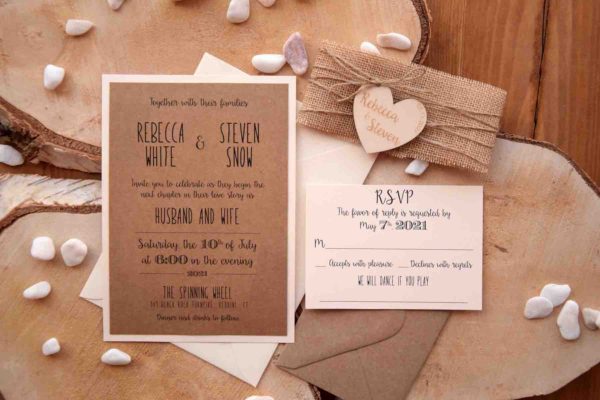A wedding invite is a perfect sneak-peek into the festivities, fun, and celebrations that are to follow. From quirky wedding websites that offer fun and personalized ways to the couple to announce the happy news to a simple invitation card with, there is no right or wrong way to celebrate your once-in-a-lifetime special day.
Traditionally, a wedding invitation is “a letter asking the recipient to attend a wedding.” It needs to have the details about the date, time, and venue, the events, and the theme of the events.
But, designing a wedding invitation for the first time can also lead to some basic mistakes – from the details that need to be mentioned to the theme of the event. Things you don’t want going wrong!

Here are 5 common wedding invitation mistakes and your way around them:
1.Selecting the Right Wedding Invitation Fit
With the wedding planning industry skyrocketing across the globe, there are a myriad number of options available for everything that goes into planning a perfect ceremony. From fancy boxes full of sweets and delicacies to the stylish and glittery wedding envelopes, a wedding invite can potentially cost a fortune.
How to avoid this mistake:
The benefit of being swamped by choices is the unrealized possibility of trying out something creative and unique for your wedding. If you find the traditional envelope invitations mainstream and pricey, you can design your wedding invitation through an invitation maker tool available on platforms like InVideo, Canva, and more. For every template, you can customize the design according to a chosen theme of the wedding. You can change the font, colour, and even the background.
2.Don’t Overload the Guests with Details
Since a wedding invite is essentially a letter asking the recipient to attend the wedding, it has to be laden with information and details. However, the information given is inversely proportional to its absorption – the more information that the guests have to process, the lesser chances that they will be able to. Likewise, if you wish to design an invite with minimal information, it might leave the guests confused.
How to avoid this mistake:
Striking a perfect balance – between an excess of information and providing minimal information – is the key. Including all the essential details like dates, time, addresses, contact details are imperative.
However, if you wish to add more details, creating a wedding website is a simpler and more lucrative idea!
3. Sending out Wrong Information is a Big No-No!
While designing your wedding invitations, make sure you not only provide all the necessary information, but also the correct information. A tiny glitch in adding the right details and all your invites could bear the brunt. Reprinting or redesigning comes with their own additional time and cost.
How to avoid this mistake:
Make sure you check everything carefully and critically as soon as you receive the first draft of the wedding invite. Ask someone else, maybe a family member or a close friend, to proofread the details. This is an effective method to avoid mistakes. A pair of fresh eyes is more efficient in catching errors than someone who has repeatedly been seeing the same text. You can also request a hardcopy of the invite to get a closer and clearer look.
4. Not Ordering a Bunch of Extra Invites
Planning a wedding can become overwhelming. From finalizing the venue, dates, the wedding dress, to all the other arrangements, it can be a daunting task. A strictly calculated attendees’ list with a selected number of invitation cards can cause a problem in case you run out of invitations. Similarly, a loosely calculated list may lead you to a bundle of extra invitations with no further use.
How to avoid this mistake:
Writing a comprehensive guest list is a perfect way, to begin with, even before you get the invitations printed. It is always advisable to get at least 10-15 extra invitations printed, to avoid incurring a heavy cost in printing the extras in the end.
5.RSVP is the Key to an Efficiently Planned Wedding
It comes as no big surprise that RSVP is an essential element while planning a wedding. A comprehensive guest-list is best complemented with the number of guests that confirm their presence and let you know in advance if they have a plus one. From your caterers to your decorators, everyone needs numbers to be prepared for your big day.
Setting an early RSVP date can escalate your efficiency in making arrangements on time, as well as ensure the presence of guests before they commit themselves to something else. Ideally, your wedding RSVP date should be 6 weeks ahead of the event.
We strongly suggest that you use InVideo, a very handy YouTube movie maker to turn your imagined invitation film into reality, without having to learn much about editing and movie making.




